一、原型继承父类的实例
//父类及其原型属性/方法 function SuperType () { this.name = ['zc','ls','ww']; } SuperType.prototype.getSuperName = function() { return this.name; }; //子类及其原型属性/方法 function SubType() { this.test = ['a','b','c','d']; } //子类型的原型指向父类型的实例(即子类的原型复制了父类的构造器以及父类原型属性/方法) SubType.prototype = new SuperType();① //为子类原型添加原型拓展属性/方法 SubType.prototype.getSubTest = function() { return this.test; } var instance1 = new SubType(); instance1.name.push('yzy');//name属性是原型继承自父类实例 instance1.test.push('e');//test属性是源于子类本身的构造器 console.log(instance1.name,instance1.test) var instance2 = new SubType(); console.log(instance2.name,instance2.test)
控制台输出:

标注:
①注意这里的子类原型指向一个父类的实例(引用传递),那么这块的父类实例就是内存中的一块地址,以后所有的子类实例都会有一个原型属性指向这块地址,并且子类A对这块地址中数据更改也会影响到子类B。
图示:
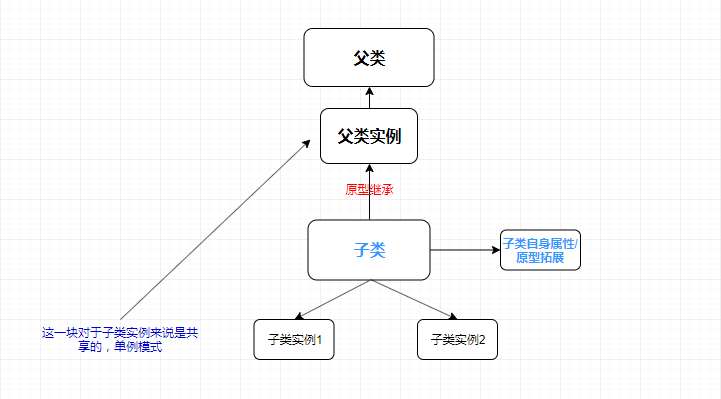
所以你可以看到,instance1.name是从父类实例来的,这个属性实际存在于这个单例,访问的时候都是引用传递,由于这个单例是共享的,instance1 push了一个数据,那么就算instance2没有任何动作,instance2读的时候数据也会是变化后的数据;
而对于test属性,是子类自身的,所以这个属性值存在于子类实例自身,相互之间互不影响,所以虽然instance1.test push了一个数据,但是instance2访问的时候丝毫不受影响。
缺点:继承自父类实例的原型属性会被所有实例所共享。
二、构造函数伪装(call()、apply())
//父类及其原型属性/方法 function SuperType(name) { this.name = name; this.color = ['green','red']; } SuperType.prototype.getSuperName = function() { return this.name; } //子类及其原型属性/方法 function SubType(name) { SuperType.call(this, name);① this.test = ['a','b','c','d']; } SubType.prototype.getSubTest = function() { return this.test; } var instance1 = new SubType('Jack'); console.log(instance1.name,instance1.getSubTest()); console.log('------------------------'); console.log(instance1.getSuperName())
控制台输出:

标注:
①call()方法实际上就是在当前作用域拷贝了一下函数执行者的构造函数/方法,所以上述call()方法实际上做了如下的事情
//子类及其原型属性/方法 function SubType(name) { //SuperType.call(this, name); this.name = name; this.color = ['green','red']; this.test = ['a','b','c','d']; }
注意的是,call()函数伪装并不会在当前作用域执行 SuperType 原型下的方法/属性
所以,因为 getSuperName() 是父类原型下的方法,所以call() 方法自然不会复制该方法给 SubType 构造器,因此控制台报错也就是理所当然的咯
缺点:函数伪装不会继承父类原型下的属性/方法。
三、组合继承(函数伪装 + 原型继承)
//父类及其原型属性/方法 function SuperType(name) { this.name = name; } SuperType.prototype.getSuperName = function () { return this.name; } // 子类1及其原型属性/方法 function SubType1(name) { SuperType.call(this, name); this.test = ['h1', 'h2', 'h3', 'h4']; } SubType1.prototype = SuperType.prototype;① SubType1.prototype.getSubTest = function () { return this.test; } // 子类2及其原型属性/方法 function SubType2(name) { SuperType.call(this, name); this.age = 18; } SubType2.prototype = SuperType.prototype; SubType2.prototype.getSubAge = function () { return this.age; } var instance1 = new SubType1('Jack'); var instance2 = new SubType2('Tom'); console.log(instance1,instance2);
控制台输出:

标注:
①这里子类原型继承自父类原型,然后子类为原型添加了原型拓展,这里的原型继承是引用传递,所以添加拓展的操作都是基于同一块内存地址的。
图示:
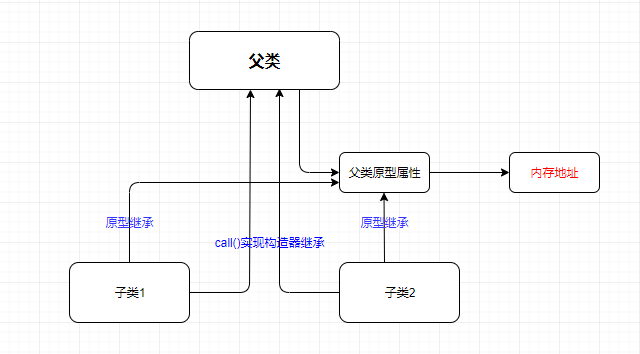
所以,无论是父类的原型属性还是子类继承的原型(父类原型),实际上都是引用传递,都指向内存中的同一块地址,因此,上述的代码,虽然子类2虽然没有原型方法 getSubTest,但是实际上子类1已经在他们指向的共同内存地址添加了该方法,同理子类1也是。
缺点:子类型的原型属性共享。
四、寄生组合式继承
function object(o) { function F() { }; F.prototype = o; return new F(); } //寄生组合式继承 ① function inheritPrototype(subType, superType) { var prototype = object(superType.prototype); subType.prototype = prototype; } //父类及其原型属性/方法 function SuperType(name) { this.name = name; } SuperType.prototype.getSuerperName = function () { return this.name; } //子类1及其原型属性/方法 function SubType(name) { SuperType.call(this, name); this.test = ['h1', 'h2', 'h3', 'h4']; } inheritPrototype(SubType, SuperType); SubType.prototype.getSubTest = function () { return this.test; }; //子类2及其原型属性/方法 function SubType2(name) { SuperType.call(this, name); this.test2 = ['s1', 's2', 's3', 's4']; } inheritPrototype(SubType2, SuperType); SubType2.prototype.getSubTest2 = function () { return this.test2; }; /* 以下为测试代码示例 */ var instance1 = new SubType(['yyy', 'Jack', 'Nick']); var instance2 = new SubType2(['yyy2', 'Jack2', 'Nick2']); console.log(instance1,instance2)
控制台输出:
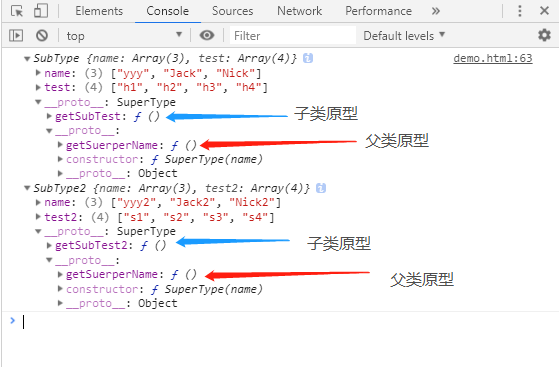
标注:
①我们看这个寄生组合式继承的处理方式,传进来一个子类和父类,子类的原型 = 新对象(新对象的原型 = 父类的原型),所以就是子类原型下的原型 = 父类的原型
这就是我们所看到的上面控制台输出的结果了,父类的原型挂在子类原型下的原型下,这样为各个子类添加原型的时候就不会影响挂在上面的父类原型了。
但是,由于依旧是引用传递,所以这个子类原型下原型(继承自父类的原型)依旧是共享的。
图示:

为达上述目的,我这边直接将父类实例挂在子类原型上,也是可以的:
//寄生组合式继承 function inheritPrototype(subType, superType) { subType.prototype =new superType();② } //父类及其原型属性/方法 function SuperType(name) { if(name){ this.name = name; } } SuperType.prototype.getSuerperName = function () { return this.name; } //子类1及其原型属性/方法 function SubType(name) { SuperType.call(this, name); this.test = ['h1', 'h2', 'h3', 'h4']; } inheritPrototype(SubType, SuperType); SubType.prototype.getSubTest = function () { return this.test; }; //子类2及其原型属性/方法 function SubType2(name) { SuperType.call(this, name); this.test2 = ['s1', 's2', 's3', 's4']; } inheritPrototype(SubType2, SuperType); SubType2.prototype.getSubTest2 = function () { return this.test2; }; /* 以下为测试代码示例 */ var instance1 = new SubType(['yyy', 'Jack', 'Nick']); var instance2 = new SubType2(['yyy2', 'Jack2', 'Nick2']); console.log(instance1,instance2)
标注:
②这里挂载在子类原型下的原型的是一个父类的实例,值得注意的是,实例化一个父类实例是会自动调用父类构造器的,所以会将父类构造器以及父类原型一同挂载到子类原型下的原型下,不妨让我们把上述例子中的父类构造器if判断去掉看看控制台输出结果:
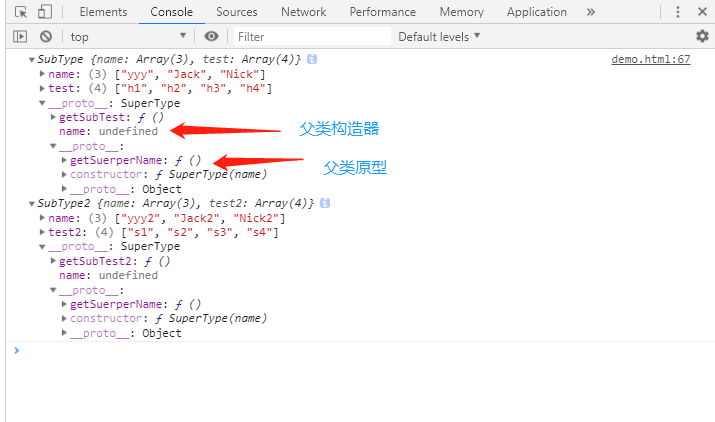
讲到这里你是不是觉得已经结束了???当然~~~没有!
上面说过:这个子类原型下原型(继承自父类的原型)依旧是共享的!
那么我后来做了个实验:
Ⅰ.父类原型属性值是基本数据类型:
//寄生组合式继承 function inheritPrototype(subType, superType) { subType.prototype =new superType(); } //父类及其原型属性/方法 function SuperType(name) { if(name){ this.name = name; } } SuperType.prototype.getSuerperName = function () { return this.name; }
SuperType.prototype.age = 12 SuperType.prototype.console = function(){ this.age += 1; console.log(this.age) };
//子类1及其原型属性/方法 function SubType(name) { SuperType.call(this, name); this.test = ['h1', 'h2', 'h3', 'h4']; } inheritPrototype(SubType, SuperType); SubType.prototype.getSubTest = function () { return this.test; }; //子类2及其原型属性/方法 function SubType2(name) { SuperType.call(this, name); this.test2 = ['s1', 's2', 's3', 's4']; } inheritPrototype(SubType2, SuperType); SubType2.prototype.getSubTest2 = function () { return this.test2; }; /* 以下为测试代码示例 */ var instance1 = new SubType(['yyy', 'Jack', 'Nick']); var instance2 = new SubType2(['yyy2', 'Jack2', 'Nick2']); instance1.console(); instance1.console(); instance1.console(); instance1.console(); instance1.console(); instance2.console();
控制台输出:

结果说明:父类原型下的age属性没有共享!
Ⅱ.父类原型属性值是非基本数据类型(例如:对象):
//寄生组合式继承 function inheritPrototype(subType, superType) { subType.prototype =new superType(); } //父类及其原型属性/方法 function SuperType(name) { if(name){ this.name = name; } } SuperType.prototype.getSuerperName = function () { return this.name; }
SuperType.prototype.age = { age:12 } SuperType.prototype.console = function(){ this.age.age += 1; console.log(this.age.age) };
//子类1及其原型属性/方法 function SubType(name) { SuperType.call(this, name); this.test = ['h1', 'h2', 'h3', 'h4']; } inheritPrototype(SubType, SuperType); SubType.prototype.getSubTest = function () { return this.test; }; //子类2及其原型属性/方法 function SubType2(name) { SuperType.call(this, name); this.test2 = ['s1', 's2', 's3', 's4']; } inheritPrototype(SubType2, SuperType); SubType2.prototype.getSubTest2 = function () { return this.test2; }; /* 以下为测试代码示例 */ var instance1 = new SubType(['yyy', 'Jack', 'Nick']); var instance2 = new SubType2(['yyy2', 'Jack2', 'Nick2']); instance1.console(); instance1.console(); instance1.console(); instance1.console(); instance1.console(); instance2.console();
控制台输出:
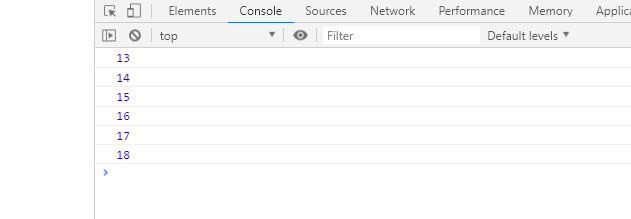
结果说明:父类原型下的age属性共享!
综上所述:
原型上的基本数据类型属性是值传递(内存地址不共享);
原型上的非基本数据类型属性是引用传递(内存地址共享)。